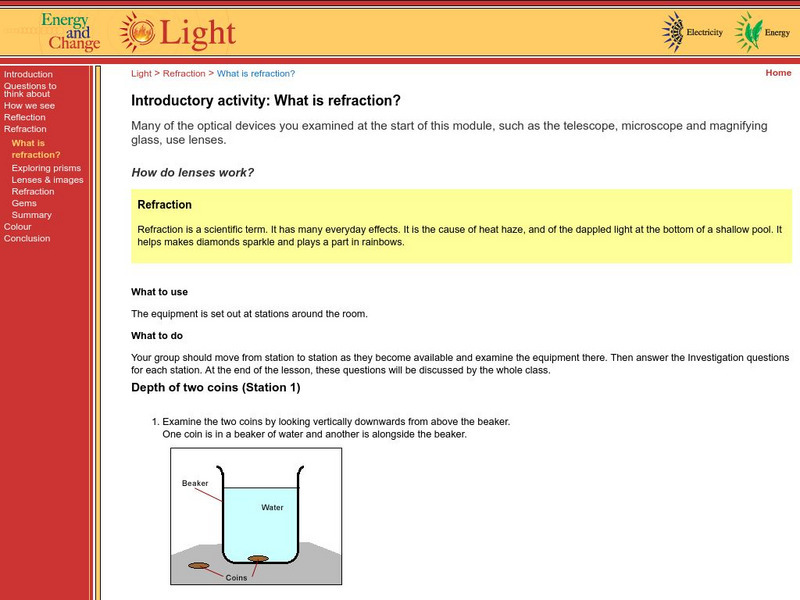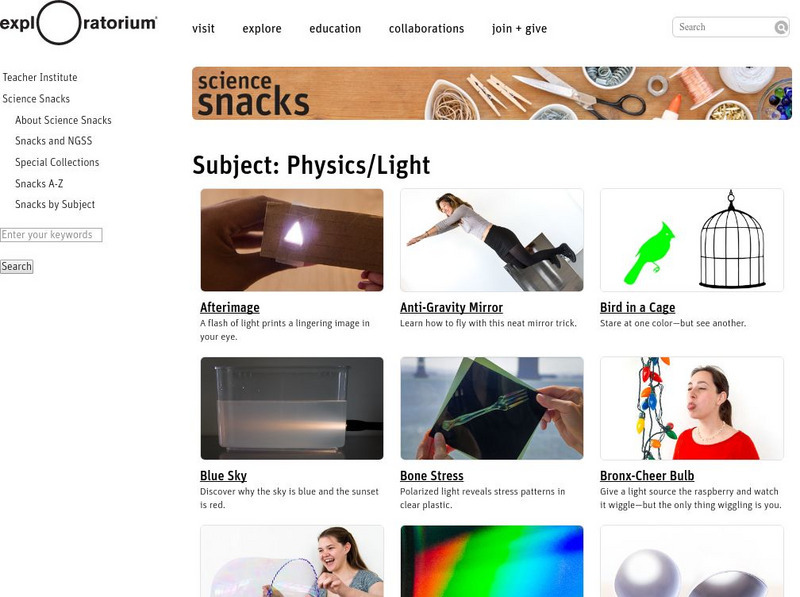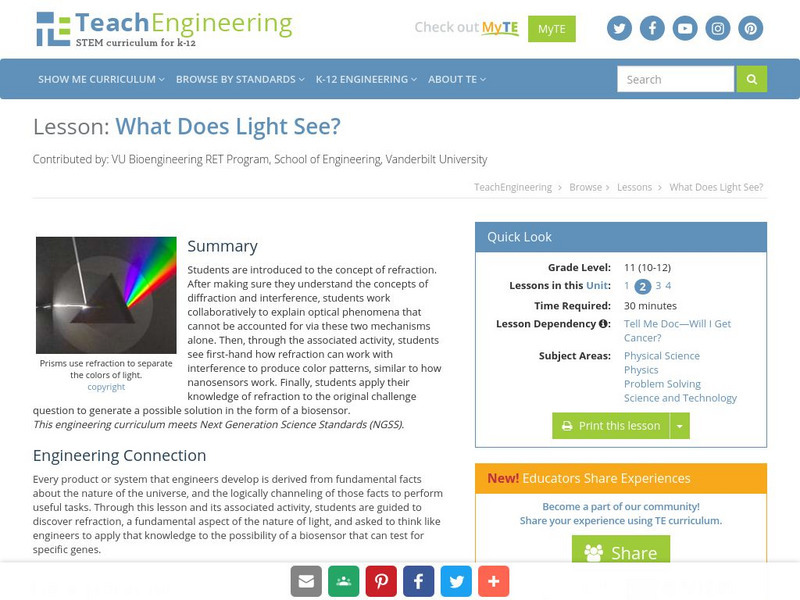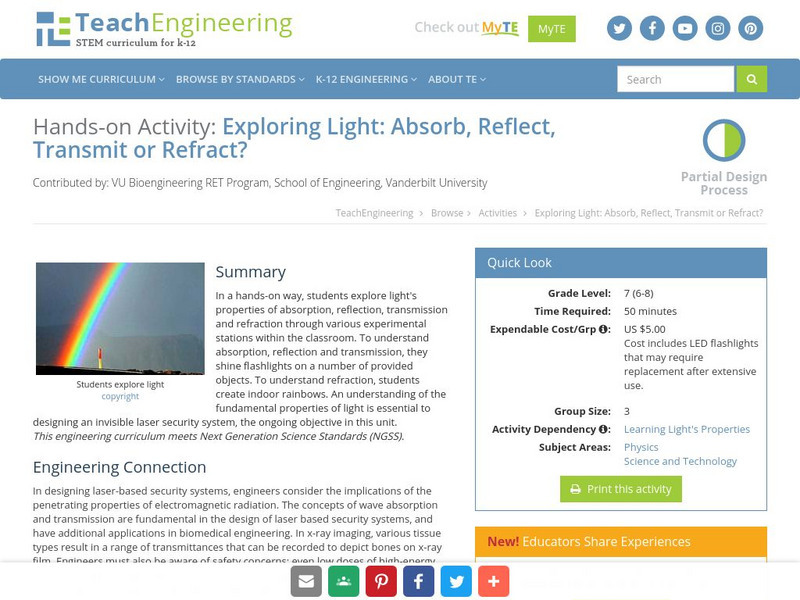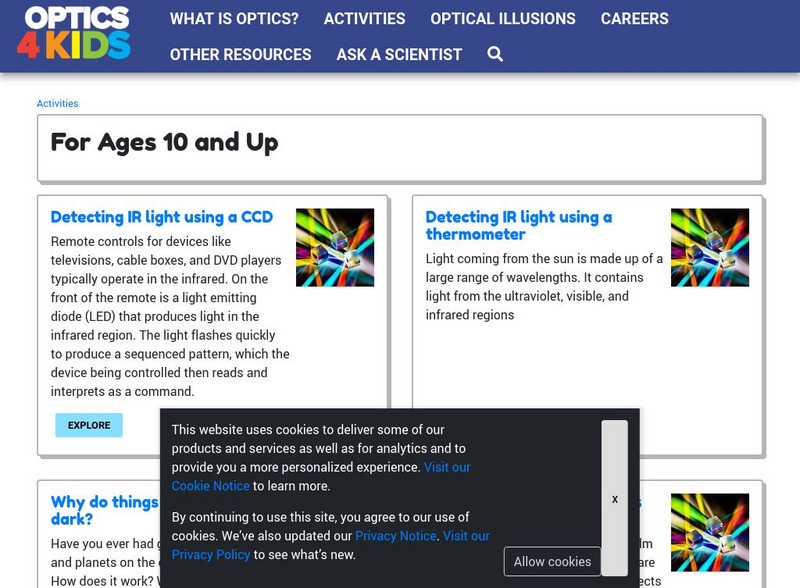Florida State University
Florida State University: Molecular Expressions Microscopy Primer: Light and Color Refraction of Light
Comprehensive and sophisticated overview of light refraction includes an historical overview of the subject and explanations of the mathematics that underpin refractive indexes, the relative index of refraction, Snell's law, and light...
TeachEngineering
Teach Engineering: Quantifying Refraction
Students learn the relevant equations for refraction (index of refraction and Snell's law) and how to use them to predict the behavior of light waves in specified scenarios.
Georgia State University
Georgia State University: Hyper Physics: Refraction of Light and Snell's Law
The meaning and cause of refraction--as well as Snell's law of refraction--are discussed. Includes an interactive problem-solving form in which visitors relate angles of refraction to the incident angle and the indices of refraction.
Other
Propagation of Light Using Geometry
A discussion of Christian Huygens' contribution to wave optics, and particularly to our understanding of the reflection and refraction of light. Excellent diagrams and a geometric proof on why the law of reflection is mathematically...
PBS
Pbs Learning Media: Observing Refraction of Light
This video segment adapted from Shedding Light on Science illustrates how light changes speed, and thus direction, in a process known as refraction. Includes background reading and discussion questions. [2:05]
Texas Education Agency
Texas Gateway: Light: Reflection and Refraction
This tutorial reviews over the properties of light. Students will learn about reflection and refraction through videos, questions, and interactive activities.
University Corporation for Atmospheric Research
Ucar: Measuring Density by Bending Light
Students observe how different materials bend light, and how we can infer the nature of the material based on the amount it bends light rays.
University of Colorado
University of Colorado: Ph Et Interactive Simulations: Bending Light
Manipulate variables and measure angles as light is refracted in this interactive simulation.
Other
Australian Government: Energy and Change: Light What Is Refraction?
Present eight different activities that can be set up as stations for students to investigate light refraction.
Physics Classroom
The Physics Classroom: Wavelike Behaviors of Light
How light waves demonstrate their wave nature by reflection, refraction, and diffraction.
University of Colorado
University of Colorado: Ph Et Interactive Simulations: Bending Light
Explore bending of light between two media with different indices of refraction. See how changing from air to water to glass changes the bending angle. Play with prisms of different shapes and make rainbows.
Exploratorium
Exploratorium: Science Snacks: Physics/light
Here is a large collection of simple science class activities for understanding the physics of light.
Physics Classroom
The Physics Classroom: Light Waves and Color
The behavior of light waves is introduced and discussed. Also, polarization, color, diffraction, and interference are introduced and discussed thoroughly as supporting evidence of the wave nature of light.
Vision Learning
Visionlearning: Physics: Light I: Particle or Wave
Instructional module focusing on light. Discussion includes historical development of particle versus wave theories and the scientific studies leading to the understanding of light waves today. Site also includes an interactive practice...
University of Minnesota
University of Minnesota: Refraction of Light
This page is a continuation of a tutorial about light reflection and refraction. It contains a diagram and suggestions on how to derive Snell's Law, which governs the refraction of light in a medium. For background to this derivation,...
Other
Gcse: Refraction
Informational site contains a mini tutorial on refraction as well as provides colorful illustrations to aide in learning.
TeachEngineering
Teach Engineering: Stations of Light
Student groups rotate through four stations to examine light energy behavior: refraction, magnification, prisms and polarization. They see how a beam of light is refracted (bent) through various transparent mediums. While learning how a...
Physics Classroom
The Physics Classroom: Refraction and the Ray Model of Light
Six complete lessons on refraction and the ray model of light. Tutorials include informational text, interactive activities, animations, and quick, interactive comprehension checks along the way.
TeachEngineering
Teach Engineering: Make That Invisible! Refractive Index Matching
Students determine the refractive index of a liquid with a simple technique using a semi-circular hollow block. Then they predict the refractive index of a material (a Pyrex glass tube) by matching it with the known refractive index of a...
TeachEngineering
Teach Engineering: What Does Light See?
Students are introduced to the concept of refraction. After making sure they understand the concepts of diffraction and interference, students work collaboratively to explain optical phenomena that cannot be accounted for via these two...
TeachEngineering
Teach Engineering: Exploring Light: Absorb, Reflect, Transmit or Refract?
In a hands-on way, students explore light's properties of absorption, reflection, transmission and refraction through various experimental stations within the classroom. To understand absorption, reflection and transmission, they shine...
CK-12 Foundation
Ck 12: Index of Refraction
[Free Registration/Login may be required to access all resource tools.] In this module, discover and solve problems involving the index of refraction, and investigate problems involving Snell's Law.
American Museum of Natural History
American Museum of Natural History: Ology: See the Light
Reflection, refraction, and the colors that make up white light is explored through lab activities after reading a brief background about light energy.
Optical Society
Optical Society of America: Exploring Science of Light: Intermediate Activities
A collection of intermediate experiments, for students aged ten and up, for exploring the magnification, reflection, and refraction of light.







